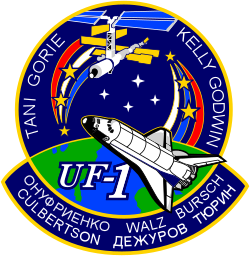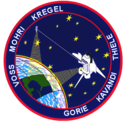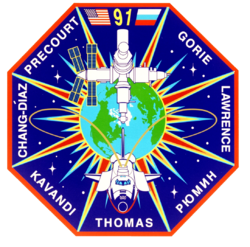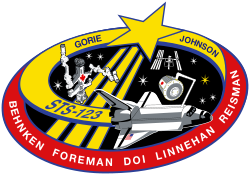Dominic Gorie
| Dominic Gorie | |
|---|---|
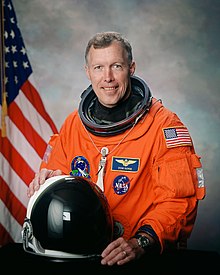 | |
| NASA Astronaut | |
| Statsborger | USA |
| Nationalitet | Amerikansk |
| Status | Aktiv |
| Født | 2. maj 1957 Alder 64 Lake Charles, Louisiana |
Andet arbejde | Pilot |
| Uddannelses- sted | United States Naval Test Pilot School Tennessee Universitet United States Naval Academy |
| Rang | Kommandør, US Navy |
Tid i rummet | 49d 00t 06min |
| Udvælgelse | NASA-gruppen fra 1994 |
| Mission(er) | STS-91 STS-108 STS-99 STS-123 STS-400 næste mission. |
| Missionsemblemer | |
Dominic Lee Pudwill Gorie (født 2. maj 1957) er en amerikansk astronaut med fire rummissioner med rumfærgen, inklusive en mission til Mir og to til Den Internationale Rumstation. Han har været 49 dage i rummet totalt.
Gorie fløj 38 kampmissioner med F-18 Hornet under Golfkrigen.
Dominic Gorie er på standby til redningsmissionen STS-400.
Rummissioner
| Logo | Rummission | Kommentar |
|---|---|---|
| STS-91 Discovery | "Pilot" - Den sidste rumfærgemission til Mir | |
| STS-99 Endeavour | "Pilot" - Shuttle Radar Topography Mission (SRTM) | |
| STS-108 Endeavour | "Kaptajn" - Bruge Raffaello Multi-Purpose Logistics Module (MPLM), levere ISS Ekspedition 4 besætningen, hente ISS Ekspedition 3 besætningen. | |
| STS-123 Endeavour | "Kaptajn" - Opsendelse af robotarmen Dextre samt logistikmodulet til det japanske Kibolaboratorium på ISS. |
Hædersbevisninger
Blandt andre:
- Defense Superior Service Medal
- Legion of Merit
- Distinguished Flying Cross (2 stk) en med Combat “V”
- Defense Meritorious Service Medal
- Joint Meritorious Service Medal
- 2 stk Air Medal
- 3 stk Space Flight Medal
Galleri
Besætning på STS-91
Besætning på STS-108, inklusive besætning på ISS Ekspedition 3 og ISS Ekspedition 4.
Besætning på STS-108
Dominic Gorie og Mark Kelly under STS-108
Eksterne henvisninger
- NASA Biografi Arkiveret 22. april 2017 hos Wayback Machine
- Spacefacts biography Arkiveret 8. marts 2008 hos Wayback Machine
Medier brugt på denne side
This is the mission patch of STS-108. Space Shuttle Endeavour is seen approaching the International Space Station. Two astronaut symbols represent the crew commanders of both ISS expeditions. The ascending one represents cosmonaut Yury Onufriyenko of Russia. (The ascending astronaut symbol shows a flag of Russia.) The descending astronaut symbol represents Frank Culbertson of the USA. This represents crew rotation, as three stars are depicted on the symbols. The space shuttle crew members are depicted along the border while the ISS crews are depicted along the chevron on the border of the patch.
- This is the insignia for the STS-108 mission, which marks a major milestone in the assembly of the International Space Station (ISS) as the first designated Utilization Flight, UF-1. The crew of Endeavour will bring the Expedition Four crew to ISS and return the Expedition Three crew to Earth. Endeavour will also launch with a Multi-Purpose Logistics Module (MPLM) that will be berthed to ISS and unloaded. The MPLM will be returned to Endeavour for the trip home and used again on a later flight. The crew patch depicts Endeavour and the ISS in the configuration at the time of arrival and docking. The Station is shown viewed along the direction of flight as will be seen by the Shuttle crew during their final approach and docking along the X-axis. The three ribbons and stars on the left side of the patch signify the returning Expedition Three crew. The red, white and blue order of the ribbons represents the American commander for that mission. The three ribbons and stars on the right depict the arriving Expedition Four crew. The white, blue, red order of the Expedition Four ribbon matches the color of the Russian flag and signifies that the commander of Expedition Four is a Russian cosmonaut. Each white star in the center of the patch represents the four Endeavour crew members. The names of the four astronauts who will crew Endeavour are shown along the top border of the patch. The three astronauts and three cosmonauts of the two expedition crews are shown on the chevron at the bottom of the patch.
STS099-(S)-001 (JUNE 1999) STS-99 INSIGNIA -- The crew members designed the flight insignia for the Shuttle Radar Topography Mission (SRTM), the most ambitious Earth mapping mission to date. Two radar antennas, one located in the Shuttle bay and the other located on the end of a 60-meter deployable mast, will be used during the mission to map Earth's features. The goal is to provide a 3-dimensional topographic map of the world's surface up to the Arctic and Antarctic Circles. The clear portion of Earth illustrates the radar beams penetrating its cloudy atmosphere and the unique understanding of the home planet that is provided by space travel. The grid on Earth reflects the mapping character of the SRTM mission. The patch depicts the Space Shuttle Endeavour orbiting Earth in a star spangled universe. The rainbow along Earth's horizon resembles an orbital sunrise. The crew deems the bright colors of the rainbow as symbolic of the bright future ahead because of human beings' venturing into space.
An international crew assigned to STS-99 takes a break from training to pose for the traditional crew portrait at NASA's Johnson Space Center (JSC). In front are international astronauts Mamoru Mohri and Gerhard P.J. Thiele, both mission specialists. In back are astronauts Janice Voss, mission specialist; Kevin R. Kregel, mission commander; Dominic L. Gorie, pilot; and Janet L. Kavandi, mission specialist. Mohri represents Japan's National Space Development Agency (NASDA) and Thiele represents the European Space Agency (ESA). The mission is scheduled as an eleven-day flight for late summer/early autumn of this year.
STS-91 CREW INSIGNIA (March 1998) --- This is the crew patch for the STS-91 mission -- the ninth flight of the Shuttle-Mir Phase One docking missions. The crew will bring back Andrew S. W. Thomas, the last long-duration American crew member flown on the Russian Space Station Mir. This mission marks the end of the Shuttle-Mir Phase One Program and will open the way for Phase Two: construction of the International Space Station (ISS). The crew patch depicts the rendezvous of the Space Shuttle Discovery with the Space Station Mir. The flags of the United States and Russia are displayed at the top of the patch and both countries are visible on the Earth behind the two spacecraft. The names of the American crew members surround the insignia on the outer areas, with the name of cosmonaut Valery Ryumin in Cyrillic at the lower right. The Alpha Magnetic Spectrometer (AMS) is an international payload planned to fly in the payload bay of Discovery. Two thin golden streams flowing into the AMS represent charged elementary particles. The detection of antimatter in space will help scientists better understand the physics and origins of the universe.
STS-91 CREW PORTRAIT (January 1998) --- The final crew members scheduled to visit Russia's Mir Space Station pose for a crew portrait during training at the Johnson Space Center (JSC). Pictured with their helmets in front are astronauts Dominic C. Gorie (left) and Charles J. Precourt. Others, from the left, are Wendy B. Lawrence, Franklin R. Chang-Diaz, Janet L. Kavandi, Valeriy V. Ryumin and Andrew S. W. Thomas. Precourt is mission commander, and Gorie, pilot, for Discovery's summer 1998 mission to Mir. Thomas, who will have been serving as a guest researcher on Mir since late January, will return to Earth with the crew members. Lawrence, Chang-Diaz, Kavandi and Ryumin are all mission specialists. Ryumin represents the Russian Space Agency (RSA). Discovery will carry the single module version of Spacehab for the scheduled nine-day mission.
Photo of STS-108 crew, as well as ISS Expeditions 3 and 4. NASA photo STS108-S-002 taken August 2001. :Standing at rear (from the left) are the four STS-108 crew members Daniel M. Tani and Linda M. Godwin, both mission specialists; Dominic L. Gorie and Mark E. Kelly, commander and pilot, respectively. In front, from the left, are Daniel W. Bursch, Yuri Onufrienko, Carl E. Walz, Mikhail Tyurin, Frank L. Culbertson and Vladimir N. Dezhurov. :Culbertson, ISS Expedition Three commander, as well as flight engineers Tyurin and Dezhurov, used the Space Shuttle Discovery on STS-105 to reach the station for a lengthy 128 day stay and then returned to Earth aboard Endeavour on STS-108. They were replaced aboard the orbital outpost by Onufrienko, Expedition Four commander, along with Bursch and Walz, both flight engineers. The Expedition Four crew accompanied the STS-108 crew into Earth orbit. Dezhurov, Tyurin and Onufrienko represent Rosaviakosmos.
Main crew of Space Shuttle mission STS-108. Astronauts Dominic L. Gorie (right) and Mark E. Kelly, commander and pilot, respectively, are seated in front. In the rear are astronauts Linda M. Godwin and Daniel L. Tani, both mission specialists.
(5-17 December 2001) — Astronauts Dominic L. Gorie (left) and Mark E. Kelly, STS-108 mission commander and pilot, respectively, photographed with a Navy wings patch on the aft flight deck of the Space Shuttle Endeavour.
STS-123 continues assembly of the International Space Station (ISS). The primary mission objectives include rotating an expedition crew member and installing both the first component of the Japanese Experimental Module (the Experimental Logistics Module - Pressurized Section (ELM-PS)) and the Canadian Special Purpose Dexterous Manipulator (SPDM). In addition, STS-123 will deliver various spare ISS components and leave behind the sensor boom used for inspecting the shuttle's thermal protection system. A follow-on mission to ISS will utilize and then return home with this sensor boom. A total of five spacewalks are planned to accomplish these tasks. The mission will also require the use of both the shuttle and ISS robotic arms. STS-123 will utilize the Station-Shuttle Power Transfer System to extend the docked portion of the mission to eleven days, with a total planned duration of 15 days. The crew patch depicts the space shuttle in orbit with the crew names trailing behind. STS-123's major additions to ISS (the ELM-PS installation with the shuttle robotic arm and the fully constructed SPDM) are both illustrated. The ISS is shown in the configuration that the STS-123 crew will encounter when they arrive.






